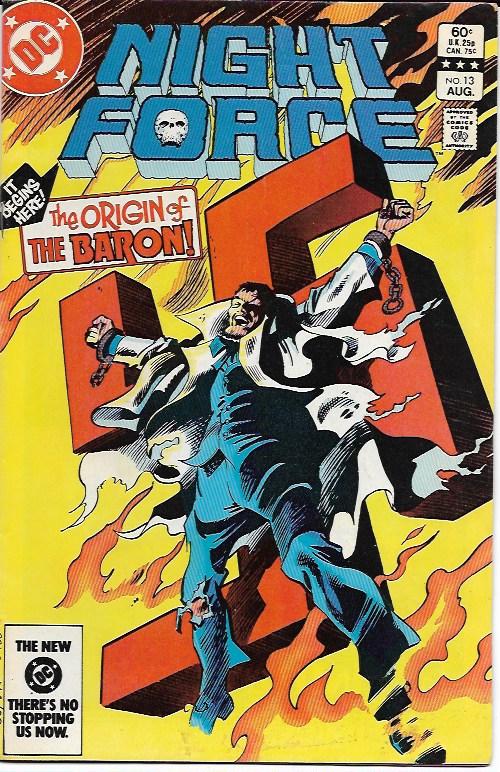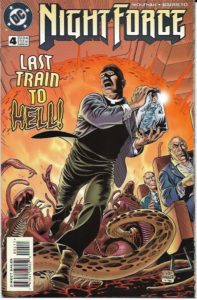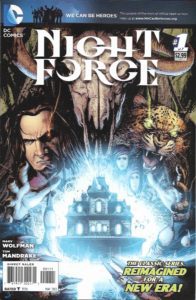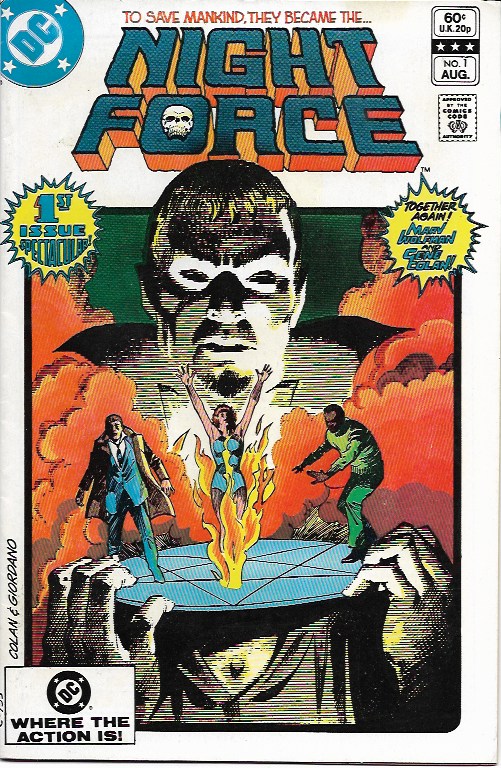It’s been a while since I tended to this column, so I thought I better drop by, sweep away the cobwebs, dust the darkened corners and weed out the flowers from the Triffid beds. While I’m here, and seeing as you’ve been kind enough to drop by, I think it would also be a good idea to write something too. The original purpose of the column was to write about horror comics and, although I’ve often deviated from this remit, I thought it would be a good idea to return to my roots.
All of which brings me to the subject of this month’s column, a sorely underrated, little known series, put out by DC comics in the 1980s, resurrected briefly in the 1990s, and then again in 2012. A series by the name of Night Force. It was something of a passion project for its creators—writer Marv Wolfman and artist Gene Colan who, nine years previously, had revived the fortunes of Marvel’s rather lackluster horror revamp—The Tomb of Dracula, turning it into the most critically and commercially successful horror comic of the 1970s.
Shortly after Tomb of Dracula was cancelled and relaunched as a black and white magazine, Wolfman quit Marvel, over disagreements with Jim Shooter, Marvel’s Editor in Chief (a role that Wolfman had previously filled) and moved to the competition, DC comics. Wolfman flourished at DC, especially after he relaunched the sidekick supergroup Teen Titans as The New Teen Titans, with artist George Perez and, within seven issues, it became DC’s biggest selling title. This success greatly increased Wolfman’s status within the company, and gave him the capital to push through projects DC might not have otherwise considered, one of those projects was Night Force.
1982, the year Night Force was launched, was not a good year for horror comics. Marvel had cancelled all of its horror titles, such as Werewolf By Night and Man Thing, and DC was in the process of retiring its long running line of mystery titles like The Unexpected, Ghosts, and House of Mystery, which had been a mainstay of its sales since the late 50s. Even Charlton, in its day the third largest comic publisher in the US, who had built their empire with a series of horror comic anthologies like The Many Ghosts of Doctor. Graves, Ghost Manor and Haunted, cancelled most of its horror titles and coasted on reprints for the next four years until it wound up its operation.
This decline in horror comics had several causes, the first of them was the increasing reliance of comics publishers on the direct market, the industry name for the comic shops springing up all over the country at that point. This market favoured comic book fans who, at the time, were far more interested in superhero titles, like the classic X-Men run from Chris Claremont and John Byrne. The market for horror comics was still at the newsstand, but they were carrying less and less comics. The other main cause was that horror was changing quite dramatically at the beginning of the 80s, A renaissance was blossoming in horror films, magazines and novels, but it wasn’t being reflected in the horror comics of the time. The mature subject matter, fresh themes and new fears being explored by horror in other mediums made traditional horror comics seem rather quaint and old fashioned. The anthology titles were by and large still written by the guys who were writing them back in the 50s, Marvel’s horror characters were very much a product of the 70s as were the black and white magazines put out by Warren Comics, only Skywald Comics published material that was in keeping with the new directions in horror, and sadly they’d gone out of business in 1975.
Given the market for horror comics at the time, it’s a measure of Marv Wolfman’s standing at DC that they would have entertained launching a new horror title. His success with The New Teen Titans probably helped, as did the fact that he lured Gene Colan away from Marvel to work with him. It’s possible DC imagined Wolfman and Colan would replicate the success they’d had with Tomb of Dracula. Wolfman most likely also convinced them he knew what would revive horror comics. His solution to the slump was to produce stories about real people facing supernatural horrors that were inspired by the headlines of the day. The approach to each story arc was closer to a novel than a comic series, with an emphasis on character, theme and concept that was unusual in comics of the day. This approach would prove to be very successful for Alan Moore on Swamp Thing, a few years later, as well as most of the subsequent horror titles put out by the DC imprint Vertigo. Wolfman was the first to adopt this approach at DC, bringing horror comics into line with what was happening in the rest of the field.
 Launched as a 16 page promotional pull out, in the pages of of The New Teen Titans, Night Force had a unique format, that remains original to this day. It’s centered around Baron Winters, an ambiguous character who appears to be in his late forties, but may well be immortal. He inhabits Wintersgate Manor, in an exclusive suburb of Washington DC, the Baron can’t leave the mansion in the present day, but different doors within the huge building lead to different times throughout history, where the Baron is free to come and go as he pleases. The Baron’s constant companion is a telepathic leopard by the name of Merlin, named after the legendary magician who, the Baron claims, gave Merlin to him as a gift. Over the course of the series we learn that the Baron is far from trustworthy however, he will seemingly say whatever it takes to manipulate those around him into doing his bidding. Merlin acts as the Baron’s conscience, chiding him when he thinks the Baron has gone too far. We never hear Merlin’s side of the conversation though, only the Baron’s replies.
Launched as a 16 page promotional pull out, in the pages of of The New Teen Titans, Night Force had a unique format, that remains original to this day. It’s centered around Baron Winters, an ambiguous character who appears to be in his late forties, but may well be immortal. He inhabits Wintersgate Manor, in an exclusive suburb of Washington DC, the Baron can’t leave the mansion in the present day, but different doors within the huge building lead to different times throughout history, where the Baron is free to come and go as he pleases. The Baron’s constant companion is a telepathic leopard by the name of Merlin, named after the legendary magician who, the Baron claims, gave Merlin to him as a gift. Over the course of the series we learn that the Baron is far from trustworthy however, he will seemingly say whatever it takes to manipulate those around him into doing his bidding. Merlin acts as the Baron’s conscience, chiding him when he thinks the Baron has gone too far. We never hear Merlin’s side of the conversation though, only the Baron’s replies.
The Baron we discover, over the course of several volumes, is an agent of balance, he’s on the side of neither good nor evil, chaos nor order, his mission is to maintain the balance between all of them. He’s guided by a higher power, and is not in complete control of his situation, but we never learn what occult forces are actually pulling his strings. Baron Winter doesn’t get his hands dirty, preferring to send others up against the supernatural forces he challenges. The agents he chooses to do his dirty work make up the Night Force of the title, ordinary people, sometimes with catastrophic flaws, chosen by the Baron for some hidden potential he sees in them.
Wolfman and Colan spent a long time preparing their first story, and its cast of characters, Wolfman wrote detailed notes on each character, going so far as to work out their astrological charts, while Colan drew pages and pages of sketches until he caught the look of the Baron and his supporting cast. This cast featured Jack Gold, a washed up journalist, who once worked for Time Magazine, but fell from grace now and makes his living on a National Enquirer style tabloid. Donovan Caine, an African American parapsychologist whose research into evil as a palpable energy force, is funded by the US government, and Vanessa Van Helsing, great granddaughter of the vampire hunter who slew Dracula. At the beginning of the first story arc, Vanessa, is confined to the Potomac Psychiatric Hospital, but it turns out her psychotic episodes have less to do with mental health and more to do with the fact that she’s a conduit for the malign energy that we call evil. Caine hopes to channel this energy to study and understand it, however, shadowy forces behind the Iron Curtain hope to use it as a weapon against the West. When these forces kidnap Vanessa, Caine and Gold, who hate each other at first sight, are sent, by the Baron first to London, then to the depths of Siberia, to rescue Vanessa from a hidden Soviet Science City. The ending of this seven and a half issue saga is especially chilling, not because of the cataclysmic denouement, but because of the emotional situation the characters find themselves in. The losses they’ve had to face and the sacrifices they make to keep the rest of the world safe. This is very grown up story telling and groundbreaking for a comic book of its day.
The next two story arcs are not as long as the first. The Beast, takes place in a crumbling apartment building. A strange, somewhat Lovecraftian visitor from the stars is holding the residents captive, while providing all their needs – food, drugs, entertainment, in order to run a bizarre social experiment. The Baron sends only one operative, a murderous criminal called Paul Brooks, whom he tricks into entering the house. Once inside, Brooks can’t escape and though he is a very poor human being, he nonetheless redeems himself and rescues the residents by the closing pages. This story arc is perhaps the most successful of the first run and has the feel of an old Outer Limits episode, similar in theme to the first season episodes – The Guests and A Feasibility Study.
Mark of the Beast, the final story arc of the first run, is a little confused, but not without its scary and poignant moments. It involves the vengeful spirits of a group of occult American financiers, who secretly bankrolled Hitler’s Third Reich. Having been murdered by the very Nazi’s they financed, the financier’s spirits are trapped in a derelict mansion in Maine, until the ruin is bought and restored by a wealthy young couple Thomas and Harriet. When they unwittingly unleash the evil spirits, the couple are forced to seek out the Baron’s help. This sees the Baron take a trip back to the 30s with Vanessa Van Helsing, and introduces Gowon and Katina, two African characters from the Baron’s past. At one point, we’re teased with the promise of the Baron revealing his origin, but instead we just get a little glimpse of his younger days as a student of the occult. Given what an ambiguous and unreliable character the Baron is, this is not surprising though. The story’s ending feels a little rushed, this may be because Wolfman and Colan had to wrap it up more quickly than they’d planned.
The first run of Night Force ended with issue 14, just as the book was really starting to hit its stride. The reason given was poor sales, but according to Wolfman, who was quoted in the magazine Back Issue: “The problem was that DC wanted to have Night Force be one of the first direct-sales books, where I believed it should be newsstand only. I felt the comic shops appealed primarily to the superhero fans, while Night Force would appeal more to the casual mainstream reader, who might not have bought comics otherwise. We got the comic-book shops’ sales early and it was canceled based on those, but when the newsstand sales finally dribbled in we actually sold pretty well. If this were later on, when DC learned to gauge newsstand versus direct sales, it probably would have survived.”
At the end of the letters page, in the final issue, Wolfman promised: “we will return, even in truncated form, as a mini-series, sometime within the year… If things pan out, the best is yet to come.” Sadly, despite these assurances, there was never any mini-series and we had to wait another four years, until the conclusion of Alan Moore’s epic American Gothic saga, in the pages of Swamp Thing #50, to see The Baron again, in a small cameo. I remember being very excited to see the Baron’s brief appearance, when reading the comic as a young teen. As a slightly older reader, I can’t help wondering if the Baron’s cameo was Moore’s way of tipping his hat to a series that had blazed a trail Swamp Thing was now following.
Though there was no mini-series, Night Force did eventually return in 1996 as part of the DC’s Weirdoverse line. This was a series of four mainstream horror titles that, unlike many of the far superior Vertigo titles, were still a part of the DC universe. The Weirdoverse was the brainchild of editor Dan Thorsland and included Book of Fate, an embarrassing attempt to make the rather staid Dr Fate appear edgy for a contemporary 90s audience. Challengers of the Unknown, which arose out of writer Steve Grant’s unused pitch to adapt the classic Kirby comic into an X-Files type TV series. Scare Tactics in which a group of monsters escape from government custody and decide to hide in plain sight by becoming a gigging rock band, and in case you’re wondering, it’s actually far worse than you’re currently imagining. The Weirdoverse line also had the single most pointless crossover ever attempted across a line of comics, in its Convergence storyline.
 All this aside, it was responsible for bringing back Night Force, which is perhaps it’s one saving grace, however the second volume of the series was occasionally let down by appalling art. Writing in the back of the comic, the assistant editor, who went by the name ‘Dread Kali’, claimed Colan could not return to doing a full time comic due to health issues. I don’t know how true that was, but Colan did at least draw the cover of the final issue in this volume and a fabulous job he did too. The volume opens really well with Millennium, a three issue story arc about a centuries old cult, whose members murder to change history and guide mankind towards utopia, then commit suicide only to reincarnate 1,000 years into the future and continue the job. Written once again by Wolfman it was drawn by the talented art team of Brent Anderson and Will Blyberg, who do a great job of suggesting the noirish, chiaroscuro style that Colan brought to the original book.
All this aside, it was responsible for bringing back Night Force, which is perhaps it’s one saving grace, however the second volume of the series was occasionally let down by appalling art. Writing in the back of the comic, the assistant editor, who went by the name ‘Dread Kali’, claimed Colan could not return to doing a full time comic due to health issues. I don’t know how true that was, but Colan did at least draw the cover of the final issue in this volume and a fabulous job he did too. The volume opens really well with Millennium, a three issue story arc about a centuries old cult, whose members murder to change history and guide mankind towards utopia, then commit suicide only to reincarnate 1,000 years into the future and continue the job. Written once again by Wolfman it was drawn by the talented art team of Brent Anderson and Will Blyberg, who do a great job of suggesting the noirish, chiaroscuro style that Colan brought to the original book.
The next story – (The) Hell (I Suffer) Seems a Heaven, is probably the best in the whole volume. A single issue, with exquisite art by Eduardo Barreto, it shows Wolfman has matured enough, both as writer and a person, to start addressing the theological and philosophical themes Night Force had previously hinted at. A truly profound and moving tale of a disenchanted priest, who is tasked, by the Baron, with deliver ingan important package by taking a train journey beset by demons. This issue is the high point of the whole second volume.
The next two storylines Dreamers of Dreams and The Eleventh Man, which ran from issues 5 to 11, reintroduced us to some old members of the Night Force including Donovan Caine, Jack Gold and Vanessa Van Helsing. As fun as it was to find out what had happened to these characters, both stories are let down by the art teams. Artist Shawn Martinbrough’s usually excellent pencils are not well served on Dreamers of Dreams by an inker who seems to have eschewed the traditional brush or pen, in favour of shoving a Hershey bar up his rectum and sitting in a bucket of ink. Even these crimes against comic art, pale next to the perfect storm of incompetence perpetrated by the art team on The Eleventh Man. The penciller, inker and colorer, (whom I won’t name here) have all done better work elsewhere, but their efforts on this story line combine to produce some of the worst art ever published by a mainstream comics company. Which is a shame, because it renders Wolfman’s otherwise excellent script almost unreadable.
Thankfully, the final issue of this volume, The Lady of the Leopard, has great art by Sergio Cariello, and hints at the cosmic forces for whom the Baron works. The Baron finds himself stranded in the Garden of Eden where the Serpent offers him an impossible choice, he has been letting his compassion rule him of late, but his job is to keep the balance between good and evil and safeguard the existence of free will for the human race. If the Baron chooses wrong then his replacement has already been groomed, but there appears to be no right decision. We never learn what his choice is, because the last book ends on a wonderful cliff hanger, that has yet to be resolved. While this would normally anger readers, myself included, it actually emphasizes the profundity of the story by refusing to give it a pat resolution.
The second volume of Night Force failed to find an audience by its twelfth issue, so DC pulled the plug on it and the whole misconceived Weirdoverse line. While the death of the Weirdoverse is rarely lamented by comic fans, or anyone with a modicum of sanity, the Night Force has only grown in critical estimation.
So much so that it was revived one last time by DC, in 2012, during the New 52 – their controversial, and ultimately abandoned, revamp of the entire line of DC characters. The seven issue maxi-series was billed as: “the classic series REIMAGINED for a NEW ERA!”, but fans who feared a radical departure from the old concept needn’t have worried, aside from a change of hairstyle, and an embarrassing goatee, that made him look like an aging hipster, the Baron, Merlin and Wintersgate Manor were exactly as we last left them.
 With fabulous art by Tom Mandrake, and a script that Wolfman considers one of the best things he’s written (and with good reason), 250 Minutes pits new Night Force agents Zoe Davis, a murder victim and abductee, and Jim Duffy, an aging cop a few days from retirement, against a shadowy, post-human cult who are breeding a sinister line of psychics and otherworldly darklings, by abducting the parents, forcibly impregnating the mothers and wiping their memories. The cult’s aim, through twelve generations of rape and abduction, is to take mankind to the brink of extinction and feed off the psychic dissonance this cataclysm will cause. However, due to a psychic slight of hand, they have managed to accomplish, what should have taken four centuries in only 250 minutes. The story unfolds at a fast pace, without sacrificing any characterization, and contains a series of killer twists that it’s doubtful you’ll see coming. If this is the last we’ll ever see of the Night Force, then it’s fair to say that they went out on a high point.
With fabulous art by Tom Mandrake, and a script that Wolfman considers one of the best things he’s written (and with good reason), 250 Minutes pits new Night Force agents Zoe Davis, a murder victim and abductee, and Jim Duffy, an aging cop a few days from retirement, against a shadowy, post-human cult who are breeding a sinister line of psychics and otherworldly darklings, by abducting the parents, forcibly impregnating the mothers and wiping their memories. The cult’s aim, through twelve generations of rape and abduction, is to take mankind to the brink of extinction and feed off the psychic dissonance this cataclysm will cause. However, due to a psychic slight of hand, they have managed to accomplish, what should have taken four centuries in only 250 minutes. The story unfolds at a fast pace, without sacrificing any characterization, and contains a series of killer twists that it’s doubtful you’ll see coming. If this is the last we’ll ever see of the Night Force, then it’s fair to say that they went out on a high point.
So far, DC has only released the first volume of the series as a collected hardback edition, but the other two volumes are easy to track down, as individual back issues, and worth searching out for Wolfman’s inspired story telling, even with the unfortunate art lapses in the second volume. Night Force is a ground breaking horror comic, that blazed a trail for so many other titles. It’s place in the history of horror comics is long overdue a reappraisal.
Trust your Uncle Jasp on this, you know it makes sense.
JASPER BARK










